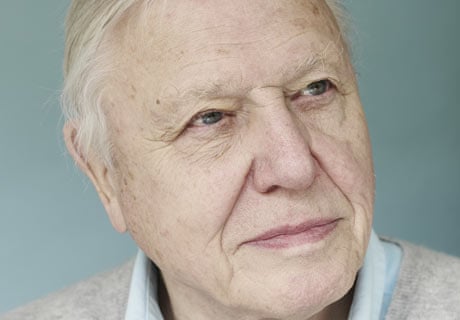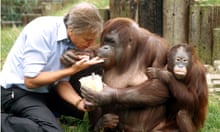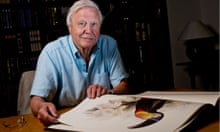It is hard to believe that Sir David Attenborough has ever mistreated a single animal in his life. This is a man for whom the natural world is sacred, after all. Yet midway through our interview, organised to promote his new television series Attenborough: 60 Years in the Wild, a crestfallen look crosses the great naturalist's features when I ask if he has any regrets about his career.
"Jumping on animals. I regret that," he states. I blink in disbelief. It is as if Judi Dench had admitted to glue-sniffing. Attenborough explains. "Fifty years ago, I used to go along, chase a giant anteater and pull it by the tail so we could film it. I am sorry about that sort of thing. But those were different days."
Then there was the time he and his crew were stuck in Borneo and strapped for something to film. "I found a little crocodile and we did a cod sequence with it. We filmed it close up so that it looked like a really big crocodile. I then took off my shirt and jumped on it. Everyone thought I had a fight with a full-sized crocodile. 'God you were brave,' they told me. I wish I hadn't done that."
And as for eating turtle eggs, he pulls a face. "They were horrible, salty. I wished I hadn't done that either."
As crimes against nature, these are minor transactions, it must be admitted. Yet they are informative – for it is easy to forget how attitudes to wildlife have changed since Attenborough began his career in 1952 on programmes such as The Pattern of Animals and, later, Zoo Quest. Wild creatures were still viewed from a Victorian perspective in those days. They were there to be tracked, captured, tied up and brought back to Britain to be goggled at. Attenborough was no different from other naturalists at the time, he admits.
Zoo Quest was certainly made in that mould, he believes. For the nine years it aired, Attenborough would travel with staff from London Zoo to a tropical country to capture an animal for the zoo's collection, a practice that was considered to be perfectly acceptable at the time. Attenborough's first assignment was to track down a white-necked Picathartes in Sierra Leone on the grounds that no other zoo in Europe had one or even knew what it looked like. "I thought: 'Oooh, a bird that no one has ever even seen. I must become the first European to get one.' It was very childish really."
Today Attenborough, like the rest of us, has a far more respectful attitude to animals, as the new series makes clear. Indeed, if Attenborough: 60 Years in the Wild has a theme it is that of transition. How attitudes to the natural world have changed and how knowledge of living things has been transformed by modern science. Not to mention the leap that has taken place in the film technology bringing the wonders of the world into our front rooms, from clockwork, wind-up cameras to stop-frame photography and thermal imaging.
An example of these technological changes is provided in the living room of Attenborough's own elegant west London home. It is dominated, not by images of wildlife or native art, as you might expect, but by a giant 50in 3D television. Now Attenborough is certainly no geek – he can't drive and has trouble answering his mobile phone, he says – but he has pioneered a recent series of 3D programmes for Sky. He is clearly in thrall to the technology and keen to demonstrate its wonders.
Attenborough bustles round the set, pulling out discs from a Blu-ray player, and flicking through scenes. The tasks involve a great deal of kneeling and bending over, which Attenborough accomplishes with no hint of stiffness or back pain that would leave many younger men groaning. Dressed in an open-neck light-blue shirt, chino slacks and loafers – an Attenborough uniform to judge from other interviews – he could easily pass for a man 20 years younger and is clearly determined to keep up with the latest developments in his profession.
"I began my career in broadcasting on the old 405 line, black-and-white TV that was broadcast from Crystal Palace," he adds. "I wasn't going to say no to doing a programme in 3D that would be displayed on huge colour screens when I was offered the chance.
"On the other hand, as a medium, 3D TV is certainly not perfect. You are limited to what you photograph. You cannot use long focal lenses because of problems with background. And the cameras require two or three men to carry them. But oh, when you see time-lapse photography of plants flowering in 3D, the results are absolutely mesmeric."
However, the real change in our perspective of the natural world is not due to improvements in TV technology but has been achieved through scientific revolutions, particularly in the fields of biology and geology. These have been the real game changers, Attenborough believes. "We forget what we have learned in the last 60 years. At university I once asked one of my lecturers why he was not talking to us about continental drift and I was told, sneeringly, that if I could I prove there was a force that could move continents, then he might think about it. The idea was moonshine, I was informed."
Yet we now know that continental drift explains a vast amount about the variation in the planet's plants and animals – for example the presence of similar families of earthworms in central Africa and in central South America – continents which were once attached to each other. Continental drift featured strongly in Life on Earth, Attenborough's first great series on the natural world, in 1979. What his old lecturer made of the programme is not recorded.
Since then a host of great scientific visionaries have been interviewed by Attenborough, with Konrad Lorenz providing an unforgettable early start. Lorenz won a Nobel prize for physiology for his work on animal behaviour and had an astonishing affinity with many species, in particular greylag geese. Would he like to appear on TV and demonstrate that empathy on the air, Attenborough asked.
Lorenz agreed and was filmed clutching a goose provided by London Zoo. "Komm, komm, mein Liebchen," he murmured to the unhappy animal which, as Attenborough relates, eventually squirted a jet of green dung straight at the great scientist, covering his trousers. Lorenz released the goose, wiped his clothes with his handkerchief before absent-mindedly blowing his nose with it. He completed his interview, on camera, with a green smear down his face.
Other stars to receive homage in 60 Years in the Wild include Jane Goodall and Dian Fossey for their ape-observation work, Francis Crick and Jim Watson for their discovery of the structure of DNA, and Richard Dawkins for his ideas about the selfish gene. "These people have completely transformed our understanding of the animal world. We see the world very differently today thanks to them."
Finding ways to film these scientific visions has taken Attenborough to every conceivable place on the planet. He donned a diving suit for underwater sequences filmed for The Trials of Life in 1990; has been lifted to the top of rainforests by cranes; spat at by cobras; flattened by a belligerent Scottish capercaillie; and, of course, been groomed by gorillas in that glorious sequence in Life on Earth.
So which spot on the planet would he recommend to give people a chance to enjoy living creatures at their best? The Galápagos with their iguanas? The Amazon rainforest? His answer comes as a surprise. "People say you cannot beat the rainforest. But that is simply not true. You go there and the first thing you think is: where the hell are the birds? Where are the animals? They are hiding in the trees, of course. No, if you want beauty and wildlife, you want a coral reef. Put on a mask and stick your head under the water. The sight is mind-blowing.
"And that, actually, is still a mystery: why are coral reefs so beautiful and colourful? It is not immediately obvious, though the wildlife is wonderful: shell-less molluscs, crustaceans and shoals of fish that do not give a damn whether you are there or not. Your first trip to a coral reef will be one of the most transforming moments of your life."
There is, of course, a downside. Coral reefs are now being destroyed at a staggering rate. Some estimates suggest around 600 square miles are lost every year, a rate double that of rainforest destruction. Reefs are dying because ocean waters are being acidified as carbon dioxide levels rise in the atmosphere as a result of human industrial activity. At the same time, rainforests are being ploughed up for farmland.
And this takes us to the darker side of the changes that Attenborough has seen in 60 years. Just as we are learning more and more about the glories of the living world, and as new breath-taking visions are being brought into our homes, we are destroying these wonders at an accelerating rate. It is a simple question of numbers, says Attenborough. "There is no problem on Earth that could not be solved quite easily if you could reduce world population. The reason that oil palms are being planted all over the place is because there are so many mouths, so many people in the west offering to pay for these forests to be cut down and palms planted for margarine, for plastics."
Plastic refuse turns out to be a particular concern for Attenborough, who is working on a film that will highlight the crises facing our oceans. "It is just tragic," says Attenborough. "You have got an albatross that comes back to feed its young. In close-up, it regurgitates the stuff it has been collecting round the world's oceans for 10 days to feed its chicks and what comes out? Bits of plastic. And then you see the chicks swallowing this plastic. If you warm the plastic, it gives off dioxins. And the litter of this stuff. You can only get rid of it if you can burn it – and then it gets worse."
It is a grim picture, though Attenborough is not without some shred of optimism. "If I have to grasp for little threads of hope, one is that humans are going to be better informed about the state of the world than they have ever been in the planet's history. Kids in Tibet are going to be talking to people in Patagonia about what is happening to the Earth and there is a chance that a worldwide, slow protest movement will grow with younger people wanting something to be done."
Much of their awareness of the living world and the perils facing its wildlife will have come from Attenborough, of course. In the past, he was criticised for not making clear his position on global warming, and for not taking on those who deny that climate change is occurring. However, in the past few years, he has been far more explicit in his warnings about the dangers our planet faces as it warms up and the polar regions melt.
Not surprisingly, these attempts at enlightenment have brought him into conflict with those who reject the idea that the Earth is in peril. For example, in the final episode of his last major series, Frozen Planet, Attenborough highlighted the impact of global warming on the polar regions. He pointed out that summer sea ice cover has declined by more than 30% over the past few decades and is causing major disruptions to the wildlife.
Nigel Lawson, former chancellor and leading climate-change denier, was unamused. "Sir David's alarmism is sheer speculation," he claimed after the programme was transmitted last year. "When it comes to global warming, [Attenborough] seems to prefer sensation to objectivity." Attenborough, said Lawson, should have acknowledged that although the extent of Arctic sea ice has been declining over the past 30 years, satellite observations have also shown that, at the other pole, Antarctic sea ice has been expanding over the same period.
Sensationalism is not an accusation that many have made about Attenborough in the past. He is a fellow of the Royal Society and was awarded the Order of Merit in 2005. He does not, generally, shoot his mouth off and many scientists were quick to jump to his defence. These included oceanographers who pointed out that yes, summer sea ice in Antarctica has increased over the past 30 years, but only slightly – by about 0.4 million square kilometres, an upward trend that may actually be no more than a reflection of year-to-year variability. By contrast summer sea ice in the Arctic has declined in extent by about 3 million square kilometres in the past 30 years: a vast decrease. Lawson was guilty of being economical with the truth, to put it mildly.
So what does Attenborough think about climate change deniers like Lawson? What should be done to counter their highly selective views about global warming?
"Well, it is difficult to know what to say except that people like him have to be allowed to make these claims so that others can assess them. Any idea of suppressing their views would be disastrous. We need to be able to see just how wrong-headed they are and how selective they are in picking data to support their ideas. They pinpoint examples to say global warming cannot be happening because it got colder in some area of the planet. That is the sort of thing they say. But, of course, that completely misunderstands the global nature of the crisis we are facing. We have to keep pointing that out. Certainly I think that most people would recognise that Lawson is up a gum tree.
"The truth is: the natural world is changing. And we are totally dependent on that world. It provides our food, water and air. It is the most precious thing we have and we need to defend it."
Attenborough: 60 Years in the Wild begins on BBC2 on 16 November at 9pm




Comments (…)
Sign in or create your Guardian account to join the discussion